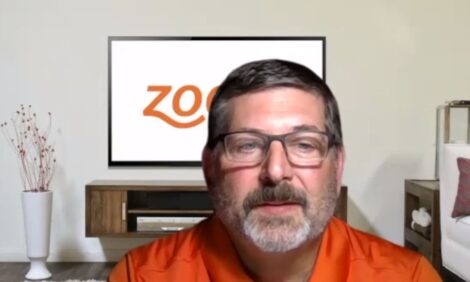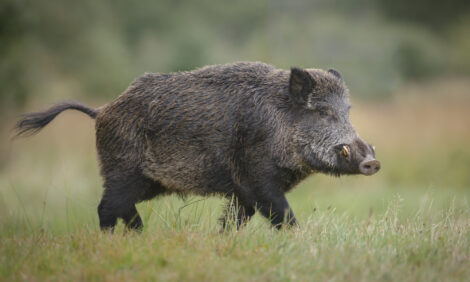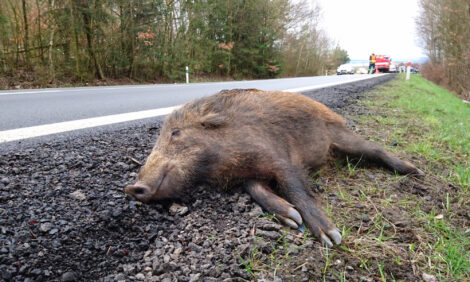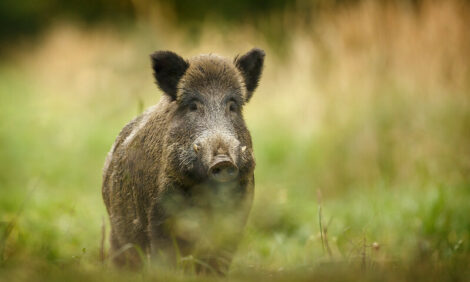



African swine fever in wild boar: effective communication between veterinary services and hunters
Learn how to identify your goals in communicating with huntersPart of Series:
< Previous Article in Series
Editor's note: the following is an excerpt from African swine fever in wild boar populations - ecology and biosecurity. It was created by the FAO, WOAH and European Commission. Additional content from the booklet will be shared as an article series.
Suzanne Kerba
Given that ASF is a highly contagious infectious disease with no cure and no vaccination options, effective risk communication and educational initiatives are critical tools in preventing its spread (Costard et al., 2015). This chapter considers these tools.
So how can veterinary services effectively communicate with hunters about ASF? Responsible hunting and disposal practices will ensure that boar populations continue to thrive and serve as a source of sport and food in the years to come. These same practices support a healthy environment for agriculture and domestic pig farming (De Nardi et al., 2017).
Engaging hunters is critical as we work towards the eradication of ASF disease.
It is critical to identify your goals in communicating with hunters. Establishing a Single Overarching Communication Outcome (SOCO) provides a road map for sharing technical information and guidance (WOAH and World Health Organization [WHO], 2015). This road map represents the actions you want to see implemented by your target population as a result of your communication. To establish your SOCO, you need to answer three main questions:
- Why do veterinary services want to stop the spread of ASF?
- ASF represents a serious threat to pig farmers worldwide.
- There are no treatments or vaccines for ASF.
- The disease can cause massive economic losses.
- The disease has been spreading in eastern Europe and the European Union.
2.What is the change veterinary services want to see as a result?
- An increased awareness of the dangers of ASF among farmers, hunters, transport-ers and the general public.
- An increase in surveillance and reporting among farmers and hunters.
- An increase in practices of ASF prevention.
- No more introduction of ASF into countries and regions free of disease
3.Why communicate now?
- There has been notification of an outbreak in the country.
- There has been notification of an outbreak in the neighbouring country or in the region.
Based on this example, your SOCO could be: Hunters take appropriate actions to monitor, prevent and control a potential ASF outbreak.
Risk communication is the real-time exchange of information, advice and opinion between experts or officials and people who face a threat (from a hazard) to their survival, health, economic or social well-being (Stoto et al., 2017). In the context of ASF, the role of veterinary services in risk communication is to provide information, listen to hunters and communicate in ways that recognize and respect the important role that hunters play in ASF prevention and eradication.
Communicating for behavioural change requires knowledge of what motivates our target audiences (Ueland, 2018). Thus, knowing what hunters believe is critical to understanding how best to communicate with them about ASF and their role in stopping the spread of disease. Using formative research in the design and planning of communications helps us understand our audiences and what motivates them (Snyder, 2007). This information will help you to tailor adequate messages and choose relevant channels of communication and education to ensure a successful risk communication.
What do we know about boar hunters? Research shows that they perceive the following issues as barriers to reporting the discovery of illness in boar (Vergne et al., 2014):
- lack of awareness of the possibility of reporting;
- lack of knowledge about how to report;
- lack of a level of agreement that a reason for them to report a hunted wild boar is because it shows suspicious lesions or disease;
- perception that the act of reporting is troublesome.
Building Strong Communication Messages For Hunters
Based on previously described insights, veterinary services will draft adequate messages to be delivered to hunters.
For example, these messages could be:
- You are important and valued partners in efforts to eradicate ASF.
- Your use of responsible hunting, reporting and disposal practices has a direct impact on the success of efforts to prevent the spread of ASF disease.
It is then necessary to adapt these messages to hunters in such a way as to reinforce their value and importance as stakeholders. Potential messages may include:
- Responsible boar hunting, reporting and disposal practices reflect the honourable role of hunters as stewards of nature and its resources.
- To be a hunter is to belong to a group that is connected to the environment in a unique and integral way.
- Success in eradicating ASF requires the active involvement of the hunting community – both individually and as a group.
Characteristics of a strong risk communication message include these elements:
Complete and specific
Gives hunters what they need to know to make an informed decision. Relevant
Appropriate to the situation; timely.
Concise
Short and to the point.
Effective communication between veterinary services and hunters
Understandable
Encoded (adapted) in such a way that hunters understand it.
Memorable
Encoded (adapted) in such a way that hunters remember it.
Positive
Empathetic and encouraging.
Courteous and respectful of hunters’ culture, values and beliefs.
To be efficient, messages need also to take into account:
The context and environment in which hunters and veterinary services are communicating:
Is there an outbreak of ASF disease or an event that may heighten awareness and prompt action?
Do hunters feel any sense of urgency about ASF?
Potential interference getting in the way of ASF messages from veterinary services to hunters:
Are rumours or misinformation undermining accurate messages from veterinary services to hunters?
Are veterinarians listening to hunters and being proactive in responding to rumours or misinformation?
Two-way Communication
As scientists and veterinarians, we often act as if knowledge alone is enough to produce results. We deliver evidence and guidelines, and we expect people to understand and follow the information we provide (Brownell, Price and Steinman, 2013). However, what people know and think affects how they act. People’s perceptions, motivations and skills all influence their behaviour. To be effective, scientific communications must reflect both facts and values (Dietz, 2013).
As sources of ASF communication with hunters, veterinary services must establish themselves as trustworthy providers of reliable information, respectful of the role of hunters and taking care to actively talk to them in clear, understandable ways.
Characteristics of an effective communicator (WHO, 2015)
Expertise – you are knowledgeable; you know what you are talking about.
Good character – you are trustworthy and honest and open in your communication.
Goodwill – you express empathy and you are respectful of people in your audience, how they feel and what they believe.
Identification – you communicate with people in a way that makes them identify with you and relate to you.
Relationships between veterinary services and hunters must support an environment of trust and confidence. Best practices for effective risk communication (Peters et al., 2013) include these elements:
Create and maintain trust
You care about me.
You know and address my concerns.
You are reliable.
Acknowledge and communicate – even in uncertainty
You are not concealing information from me.
Coordinate your communication
You agree with other credible experts.
Be transparent and accurate with all communication D You are telling me the truth.
You are seeking solutions.
Always include messages of self-efficacy
I have an active role in making an informed decision.
Two-way communication includes the importance of listening to the target audience to better understand them (rumour listening, etc.), as well as to evaluate the impact of your risk communication effort. For this to be effective, you need to establish in advance a mapping of your stakeholders and of their influencers, and to collect feedback on how hunters respond to ASF messages and guidance.
- What are hunters saying to veterinary services in response to their communication about ASF?
- Are veterinary services listening to hunters and using their feedback to improve future communication?
- Are messages from veterinary services motivating hunters to follow guidance and implement responsible hunting, reporting and disposal practices? If not, why?
Stakeholder mapping involves identifying key audiences, and determining the priorities, challenges and values important to each of them. The process also involves identifying the most influential stakeholders and working to ensure that their input is used to shape communication efforts. Relationships between stakeholders, and the strength of those relationships, impact the perceptions and behaviours of everyone involved. Two-way communication between appropriate shareholders provides a balance of opinions, increasing the likelihood that hunters and veterinary services reach a common ground in their efforts to stop the spread of ASF.
Choosing Communication Channels
Once you have crafted your communication messages to hunters, it is time to determine the tactics and channels you will use to reach them. Channels may include:
- radio, television, print materials;
- word of mouth;
- communication with clubs and organizations;
- social media;
- awareness campaigns;
- stakeholder engagement;
- partner engagement;
- social mobilization;
- community engagement.
Not all channels will be appropriate for communication associated with ASF. As you go about putting together a plan for ASF communication aimed at hunters, consider the channels that meet hunters where they are – respecting their language, recognizing their social networks and honouring their cultural values.
The following questions can help you identify risk communication channels that will effectively help to reach hunters:
- Will this channel help me reach hunters?
- Am I using a channel they respect and/or pay attention to?
2. What level of impact does this channel have on hunters?
- Do they see value in this channel’s position in the community?
3. Will using this channel advance my goals?
- Prevent the introduction of ASF into countries and zones free of disease
- Build awareness of ASF and its risks.
- Inform on signs and symptoms.
- Advise on prevention techniques.
- Outline hygiene regulations and practices.
- Encourage the adoption of mitigation strategies.
- Enhance biosecurity.
- Increase reporting hunters.
Risk Communication And Stigma
Whenever there is an outbreak of ASF or the discovery of an infected pig or boar, people invariably seek information about the origin of the disease. Where did this outbreak start? Which forests or farms are implicated? These are legitimate concerns, and veterinary services have an obligation to actively listen and to respond promptly and honestly.
As they respond, veterinary services must also consider the possibility that hunters who report infected animals may face stigma, which means they may become needlessly associated with the threat of ASF. People experiencing stigma may face criticism, and they may suffer stress, anxiety and emotional pain from social rejection (Smith, 2007). Fear of stigma may also make farmers hesitant to report disease (Guinat et al., 2016).
People who stigmatize others generally feel that the problem facing someone else is a problem that they themselves can control (Reynolds and Seeger, 2005). For example, farmers who stigmatize other farmers whose pigs have contracted ASF may believe that they can control an outbreak themselves. Entire regions and communities (including hunters) may be stigmatized if people start identifying them with a perceived risk.
It is the role of veterinary services to balance the real risk of ASF with the needless association of one person or identifiable group with the disease itself. Veterinary services must take an active role in dispelling misconceptions and correcting faulty assumptions. When stigma arises, it is the responsibility of veterinary services to counter it with scientific facts and appeals for fairness. Hunters who face stigma associated with ASF must be able to rely upon veterinary services for proactive support.
This includes using messages such as:
“The discovery of illness demonstrates that we are ALL at risk of ASF.”
“These circumstances are not defined by any one group in a particular place or area.”
“This situation reinforces the importance of using responsible biosecurity and disposal practices. We must all work together to stop the spread of ASF.”
KEY MESSAGES
- Successful communication between veterinary services and the boar hunting community are critical as we work together towards the eradication of ASF disease.
- Risk communication and community engagement involve hunters in creating effective solutions that support their efforts to use responsible biosecurity and disposal practices. Working together in a coordinated way enhances the likelihood that we will be successful in our shared vision of a world free from the threat of ASF.
Guberti, V., Khomenko, S., Masiulis, M. & Kerba S. 2022. Chapter 4. African swine fever in wild boar – Ecology and biosecurity. Second edition. FAO Animal Production and Health Manual No. 28. Rome, FAO, World Organisation for Animal Health and European Commission. https://doi.org/10.4060/cc0785














